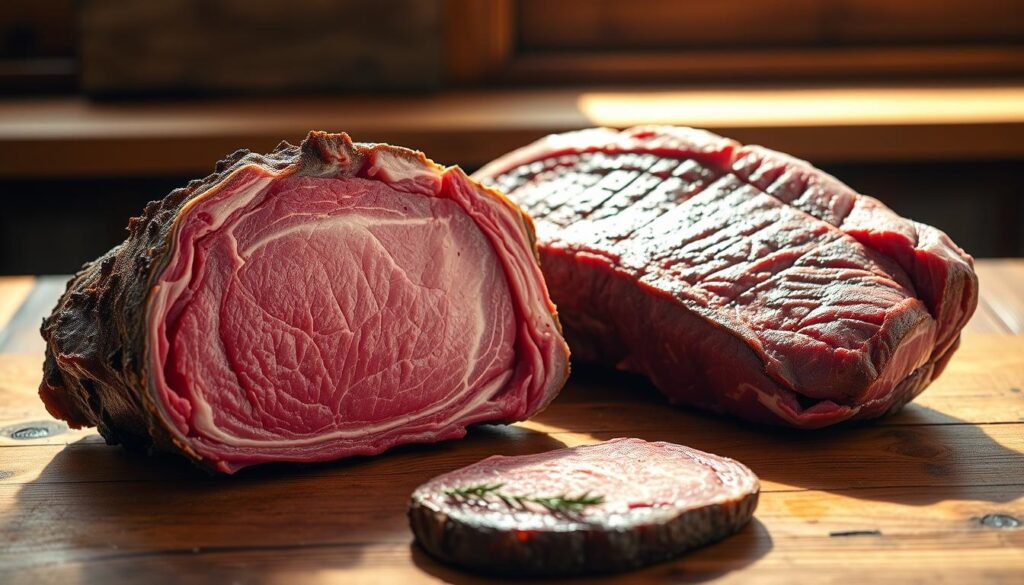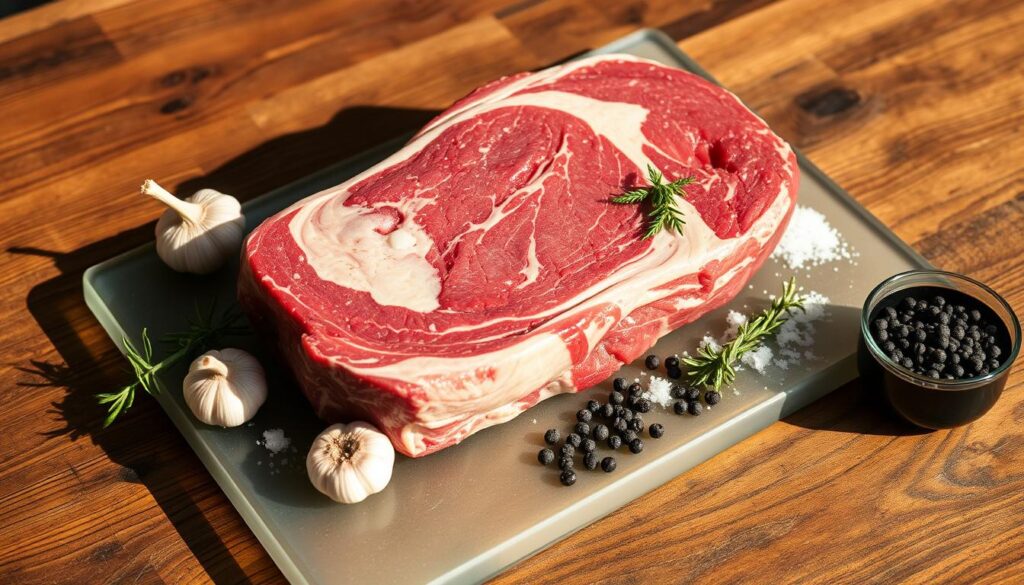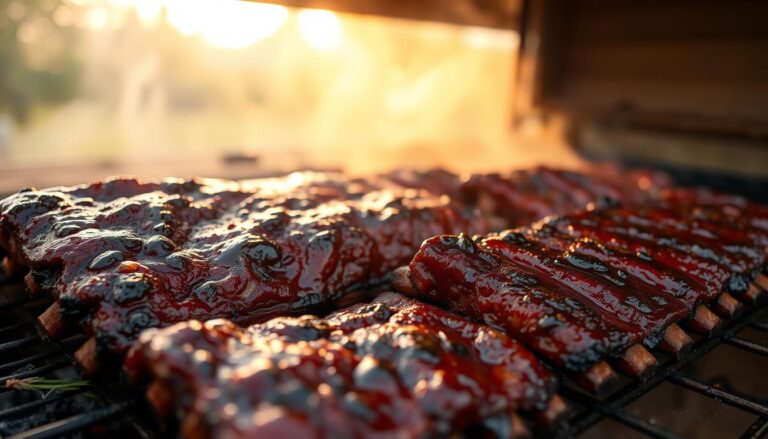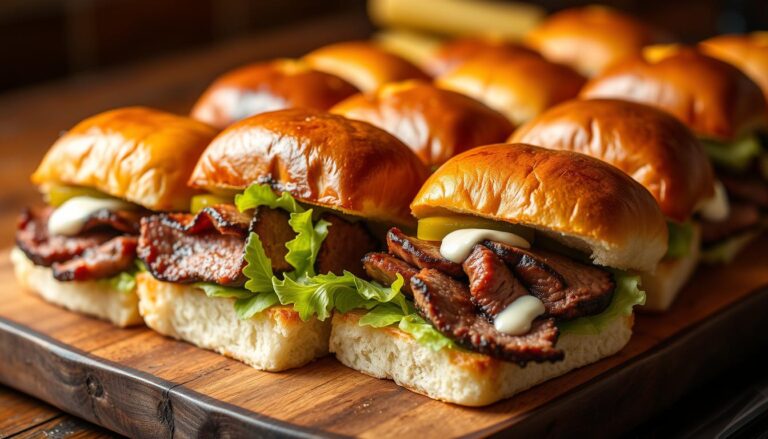Pure Indulgence: Ribeye Prime Rib Roast Recipe Perfection
Every family gathering has that one dish that makes the meal unforgettable. For me, the ribeye prime rib roast recipe is that dish. It’s the centerpiece that everyone looks forward to.
Watching my grandmother prepare this beef ribeye roast recipe was special. It was like seeing a delicious tradition come to life. Preparing the perfect ribeye prime rib roast is more than cooking meat. It’s about creating a memorable experience that brings people together.
Whether you’re an experienced cook or new to holiday meals, this guide will help. You’ll learn how to make a beef roast that will impress your guests. They’ll be asking for seconds in no time.
Table of Contents
Key Takeaways
- Select a high-quality ribeye prime rib cut for best results
- Room temperature preparation is crucial for even cooking
- Use a meat thermometer to achieve perfect doneness
- Allow proper resting time after cooking
- Invest in a good herb and garlic butter rub
- Practice proper carving techniques
Understanding Prime Rib vs Ribeye Roast: Key Differences
Exploring rib roast cuts can be exciting. Knowing the differences between prime rib and ribeye roast can make your cooking better. Both come from the same area of the cow but have their own special traits.

The world of prime grade beef has many tasty options for meat lovers. Let’s look closer at these amazing cuts.
Prime Rib Cut Characteristics
Prime rib is known for its bone-in standing roast. It has some key features:
- Includes the rib bones, which enhance flavor during cooking
- Usually larger and more dramatic presentation
- Often sold as a full seven-bone roast
- Renowned for exceptional marbling and tenderness
Ribeye Roast Features
Ribeye roast has its own special qualities for meat lovers:
- Typically boneless cut from the same rib section
- More compact and uniform in shape
- Ideal for precise portion control
- Consistently tender with rich beef flavor
Quality Grades Explained
Prime grade beef quality is based on USDA grading standards:
| Grade | Marbling | Tenderness |
|---|---|---|
| Prime | Abundant | Extremely Tender |
| Choice | Moderate | Very Tender |
| Select | Slight | Moderately Tender |
Knowing these differences in rib roast cuts helps you choose better for your next meal.
Essential Ingredients for a Succulent Ribeye Prime Rib Roast Recipe

Creating the perfect beef roast starts with choosing high-quality ingredients. These ingredients will make your meal go from good to great. Your garlic herb crust needs the right parts to bring out the meat’s natural flavors.
The base of your beef roast is all about premium ingredients. You’ll need these key items to make a meal you’ll remember:
- High-quality beef roast (prime or choice grade)
- Kosher salt
- Freshly ground black pepper
- Fresh herbs (rosemary, thyme, sage)
- Unsalted butter
- Fresh garlic cloves
Your garlic herb crust needs careful attention. Fresh herbs are key for deep, rich flavors. The mix of minced garlic, chopped herbs, and soft butter makes a magical crust. It keeps the meat moist and adds amazing depth.
| Ingredient | Quantity | Purpose |
|---|---|---|
| Beef Roast | 4-5 lbs | Primary protein |
| Kosher Salt | 2-3 tablespoons | Seasoning and tenderizing |
| Fresh Garlic | 4-5 cloves | Flavor enhancement |
| Fresh Herbs | 1/4 cup chopped | Aromatic complexity |
| Unsalted Butter | 1/2 cup | Moisture and richness |
Professional chefs say the quality of ingredients is what makes a beef roast great. By picking the best parts and preparing them well, you’ll make a garlic herb crust that will wow everyone.
Preparing Your Roast: Tips for the Perfect Starting Point
Learning how to cook a small standing rib roast starts with preparation. The right steps can turn a simple cut into a memorable meal. This ensures your ribeye roast with bone in is a hit.
Before cooking, several key steps are vital for a perfect roast. Knowing these techniques can greatly improve your dish.
Room Temperature Guidelines
It’s important to bring your roast to room temperature before cooking. Meat straight from the fridge cooks unevenly. This can lead to a tough outside and raw inside.
- Remove roast from refrigerator 1-2 hours before cooking
- Place on a clean cutting board
- Allow to sit in a cool, dry area
- Cover loosely with paper towel to prevent bacterial growth
Trimming and Tying Techniques
Trimming the roast is key for flavor and even cooking. While some fat is good, too much can hinder seasoning and cooking.
| Trimming Step | Purpose |
|---|---|
| Remove excess external fat | Improve seasoning penetration |
| Leave thin fat layer | Maintain moisture and flavor |
| Tie roast with butcher’s twine | Ensure uniform shape for even cooking |
Surface Preparation Methods
The last step is to prepare the surface for flavor. This step seals in juices and creates a tasty crust.
- Pat roast completely dry with paper towels
- Apply light coating of kosher salt
- Let salt sit for 30-45 minutes before additional seasoning
- Optional: Apply light oil to enhance browning
These steps are crucial for a top-notch ribeye roast. They will impress your guests and fulfill your cooking dreams.
Creating the Ultimate Garlic Herb Butter Rub
Making the perfect garlic herb crust can take your ribeye prime rib roast recipe to the next level. The trick is to make a flavorful butter rub. This rub should enhance the beef’s natural taste without overpowering it.
Begin with high-quality unsalted butter that’s at room temperature. This is the best base for your herb mix. Pick fresh ingredients to bring your dish to life:
- Fresh garlic (minced finely)
- Chopped herbs like rosemary, thyme, and parsley
- Kosher salt
- Freshly ground black pepper
- Optional: lemon zest for brightness
To mix your garlic herb crust, blend softened butter with finely chopped herbs and garlic. The goal is to get a mix that coats the roast evenly. Gently rub the mix onto the meat’s surface, making sure it covers all areas.
Pro tip: Make your garlic herb butter rub at least an hour before you put it on the roast. This lets the flavors mix well, making your seasoning richer and more complex.
Try different herb mixes to find your favorite. Some chefs add smoked paprika or dried herbs for more flavor.
Temperature and Timing Guidelines for Perfect Doneness
To get the perfect prime rib roast, you need to be precise and patient. Slow roasting makes the meat tender and juicy. It will surely impress anyone who tries it.
Knowing the right internal temperatures is key for a delicious ribeye roast. Your meat thermometer is your best friend in this cooking adventure.
Internal Temperature Chart for Doneness
| Doneness Level | Internal Temperature | Final Temperature After Resting |
|---|---|---|
| Rare | 125°F | 130-135°F |
| Medium Rare | 135°F | 140-145°F |
| Medium | 145°F | 150-155°F |
| Medium Well | 150°F | 155-160°F |
| Well Done | 160°F | 165-170°F |
Cooking Times per Pound
- Slow roasting at 325°F: 20-25 minutes per pound
- Slow roasting at 350°F: 15-20 minutes per pound
- For a 4-pound roast, expect approximately 1-1.5 hours of cooking time
The Importance of Resting
Resting your roast is crucial. Let your meat rest for 15-20 minutes after cooking. This step makes each slice tender and full of flavor.
Pro tip: Cover your roast with aluminum foil during rest. It keeps the meat warm and the temperature stable.
Step-by-Step Cooking Method for Bone-in Rib Eye Roast
Cooking a bone in rib roast needs precision and attention to detail. To get that restaurant-quality taste at home, you must know the right cooking technique.
First, heat your oven to 450°F (230°C). This high heat makes the outside crispy and seals in the juices. Here’s how to cook your bone-in ribeye roast:
- Take the roast out of the fridge 1-2 hours before cooking to warm up
- Wipe the roast dry with paper towels for a better sear
- Season it well with your herb and garlic butter rub
- Put the roast bone-side down in a heavy roasting pan
The cooking time depends on the roast’s size. Here’s a quick guide for internal temperatures:
| Doneness | Internal Temperature | Cooking Time (per pound) |
|---|---|---|
| Rare | 125°F | 15-18 minutes |
| Medium Rare | 135°F | 18-20 minutes |
| Medium | 145°F | 20-22 minutes |
After searing for 15-20 minutes, lower the oven to 325°F (165°C). This slow cooking keeps the inside tender and the outside crispy. Always use a meat thermometer to avoid overcooking.
Pro tip: Let the roast rest for 15-20 minutes after cooking. This makes it juicy and tender.
Making Rich Au Jus From Pan Drippings
Turning your beef roast pan drippings into au jus gravy is key to a great dish. The right steps can make simple drippings into a top-notch sauce. This will wow your dinner guests.
Making great au jus gravy needs precision and knowing how flavors develop. Start right after you take your beef roast out of the pan.
Collecting Your Drippings
To get the most flavorful au jus, follow these steps:
- Let the roasting pan cool for 5-10 minutes
- Carefully tilt the pan to collect all liquid
- Use a fat separator to remove excess grease
- Strain drippings through a fine-mesh sieve
Seasoning and Finishing Touches
Improving your au jus gravy means adding the right seasonings. Try these tips:
- Deglaze the pan with beef broth or red wine
- Scrape up all browned bits for maximum flavor
- Simmer the liquid to concentrate flavors
- Season with fresh herbs like thyme or rosemary
The outcome will be a rich, glossy au jus gravy. It will perfectly match your beef roast, adding depth and moisture to every bite.
Proper Carving Techniques for Prime Rib
Carving your ribeye prime rib roast right is key to showing off its flavor and tenderness. After letting it rest for 15-20 minutes, start carving with care and precision.
First, pick a sharp knife with a long, thin blade. This makes clean, even slices that show off the meat’s texture. It’s important to know the meat’s grain direction for tender slices.
- Let the roast rest at room temperature for 15-20 minutes after cooking
- Use a sharp, long-bladed carving knife
- Identify the meat’s grain direction
- Cut against the grain for optimal tenderness
For bone-in roasts, remove the bones before slicing. Cut parallel to the bones to separate the meat from the rib rack. This makes neat, professional-looking slices and helps control their thickness.
When slicing, aim for cuts that are 1/2 to 3/4 inch thick. Place the slices on a warm platter, slightly overlapping to keep them moist and appealing. Remember, proper carving turns your prime rib into a memorable dining experience.
Best Side Dishes to Complement Your Roast
To make your holiday meal unforgettable, pick the right side dishes for your beef roast. The perfect sides can turn a simple roast into a feast that wows your guests. It’s all about the flavors and textures that come together.
For a prime rib or beef roast, choose sides that balance rich tastes and offer different textures. Here are some top picks:
- Roasted Rosemary Potatoes: Crispy outside, soft inside
- Creamy Yorkshire Pudding: A classic British side for beef roast
- Caramelized Roasted Vegetables: Colorful and full of nutrients
- Garlic Parmesan Asparagus: A fancy and tasty green side
When planning your holiday meal, aim for a balanced plate. Roasted root veggies add earthiness, while creamed spinach brings a smooth touch. Your beef roast needs sides that enhance its flavor without overpowering it.
Pro tip: Cook most side dishes while your roast rests. This way, everything is hot and ready to serve at the same time. It keeps the meal warm and lets you focus on the presentation.
- Timing is key for a great holiday meal
- Balance flavors and textures in your menu
- Choose sides that highlight your beef roast
Your chosen side dishes will make your beef roast a memorable meal. It’s a celebration of flavors and tradition.
Storage and Leftover Ideas
Enjoying a delicious prime rib roast leaves you with tasty leftovers. Learning how to store and use your beef roast can make your meal last longer. It also helps reduce food waste.
Proper Storage Methods
Storing your leftover beef roast right is key to keeping its flavor and safety. Here’s how to keep your meat fresh:
- Cool the beef roast to room temperature within 2 hours of cooking
- Wrap tightly in aluminum foil or plastic wrap
- Store in an airtight container in the refrigerator
- Consume within 3-4 days for optimal taste and quality
Creative Leftover Ideas
Turn your leftover beef roast into exciting new dishes. Your family will love these tasty ideas:
- Prime Rib Sandwiches: Slice thinly and layer on crusty bread with horseradish sauce
- Beef Roast Salad: Chop and toss with mixed greens and vinaigrette
- Hearty Beef Stroganoff: Dice and mix with creamy sauce and pasta
- Breakfast Hash: Dice and sauté with potatoes and eggs
When reheating your beef roast, use low heat to avoid drying it out. A gentle warming in the oven or microwave with a splash of beef broth keeps it moist. This helps preserve the meat’s tender texture.
Conclusion
Learning to make a ribeye prime rib roast is more than cooking. It’s about creating a special moment that turns a simple dinner into a memorable event. This guide has given you the tools to make a dish that rivals those in restaurants, perfect for holidays or family gatherings.
Every step, from picking the best beef to mastering temperature control, boosts your confidence in cooking. The detailed steps help you roast this amazing cut with ease. Your hard work will pay off with every delicious dish you make.
Cooking is a journey of learning and trying new things. This recipe is a solid base, but feel free to make it your own. With practice, you’ll get better at making a juicy roast that will be a favorite in your kitchen.
Your adventure in prime rib roasting begins today. Dive in, trust yourself, and enjoy the amazing flavors you’ll create.



